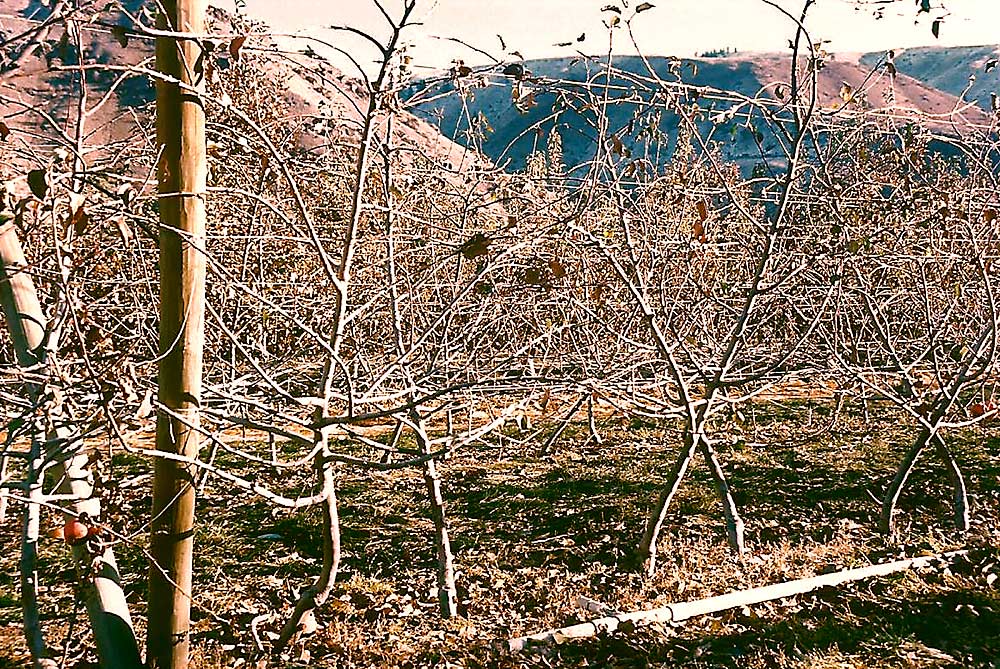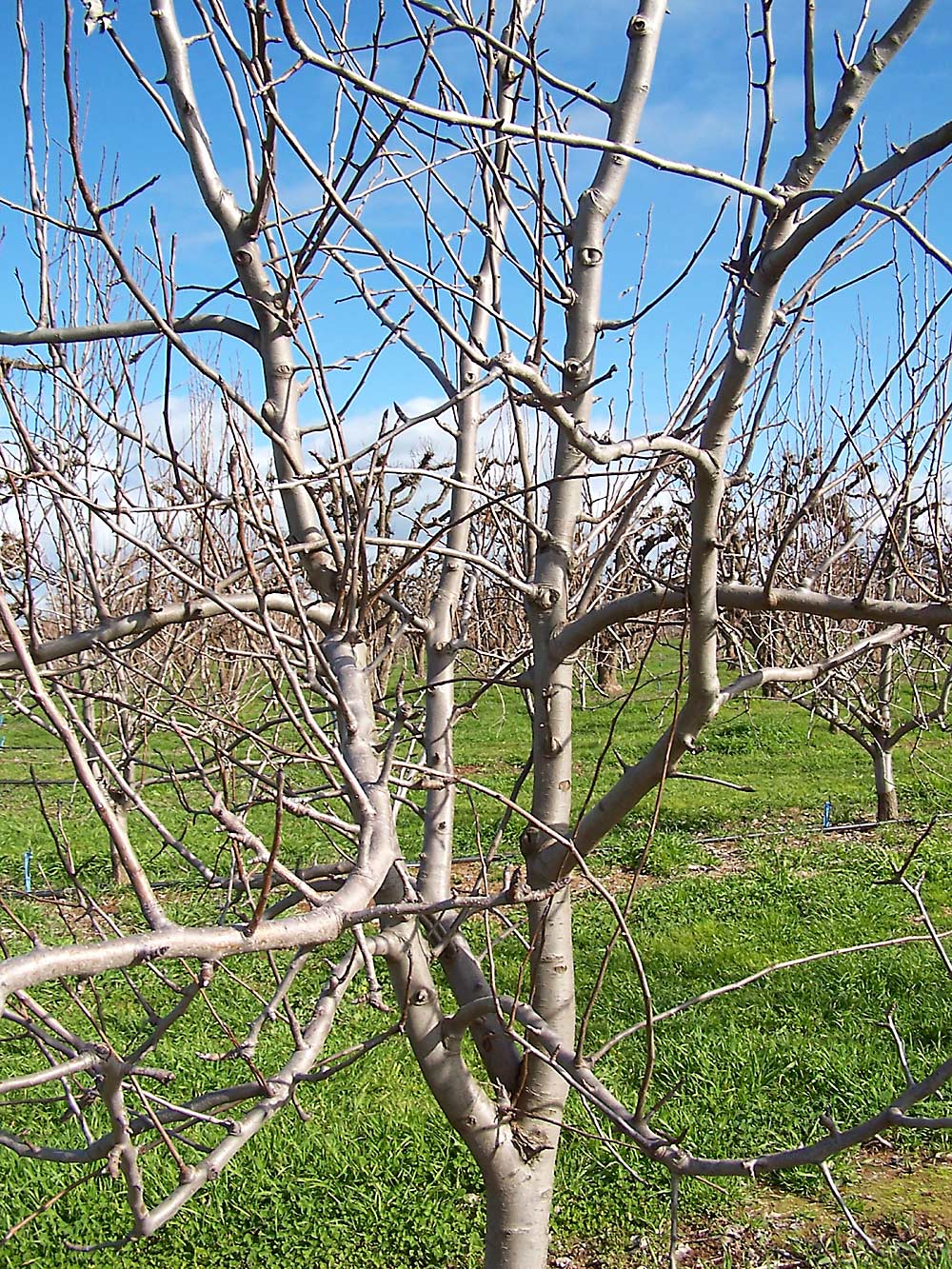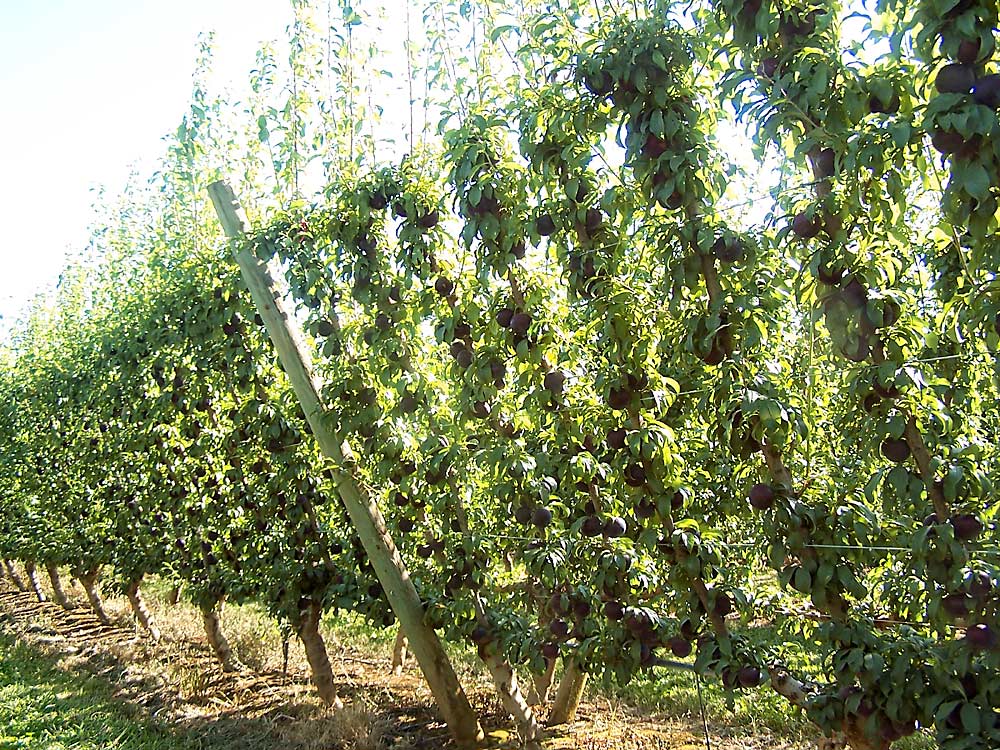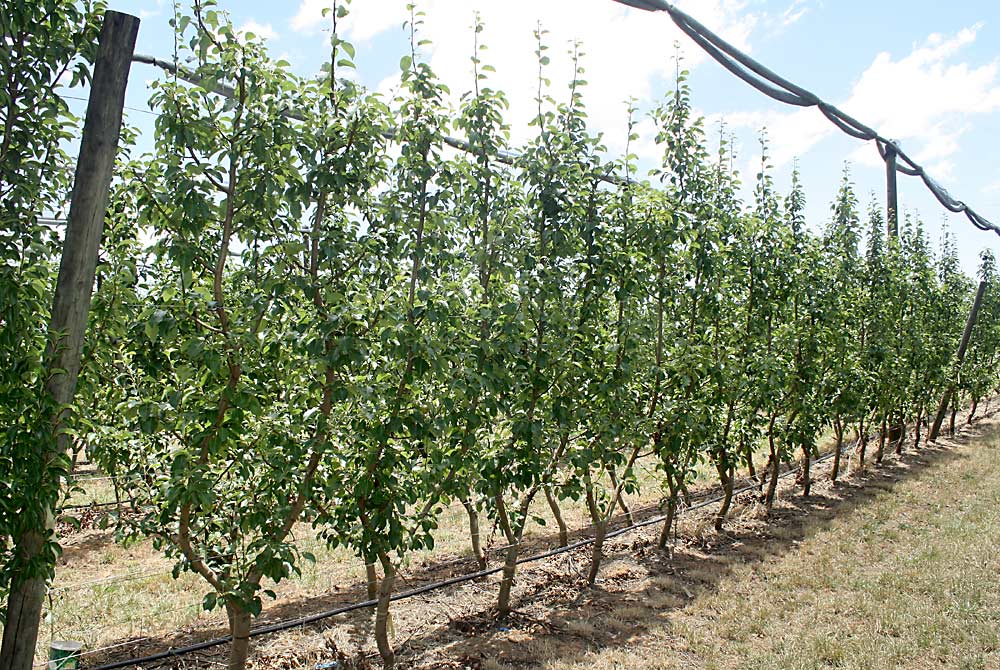
While there are many issues facing orchardists today, producing fruit of high quality at a reasonable cost remains at the top of the list. This means that orchardists must continue to produce fruit efficiently and also make sure that whatever they do makes sense and is based on sound horticultural principles.
For better distribution of sunlight throughout the canopy, for example, orchardists must continue to use size-controlling rootstocks that increase the ratio of bearing-surface to the volume of the canopy.
There are many systems of tree training that orchardists could use. However, I have noticed during my 62 years as a horticulturist, that branches and limbs make management and productivity of trees difficult.
Why is this so?
By definition, a branch is a permanent part of the structure of a tree, normally referred to as the secondary structure, where the leader, or stem, is the primary structure of the tree. A branch has leaves, laterals and spurs as well as fruiting units.
Branches must be created. It would be desirable to create the branches in the nursery to achieve early cropping. However, in Australia, environmental conditions and cultural techniques often prevent fruit growers from obtaining and planting “well-feathered” nursery trees. Nursery trees are usually delivered as whips or have a few branches (feathers) at different positions on the trees.
After planting the nursery trees, orchardists must decide how to prune the trees and use a number of methods to induce branching to increase canopy density and bearing-surface area, which is the foundation of a productive orchard.
Many things can go wrong in developing a good lateral branching system. Methods to achieve this need to be done at specific times of the year and require know-how and skill to carry out.
Strong branches
A common problem in many orchards is that more branches or limbs are kept within the tree canopy than are necessary. Pruning often does not remove excessive and high-vigor branches as young developing canopies change into their mature size. Keeping too many branches, especially strong branches, for too long creates shading that not only reduces fruit quality but limits the retention and replacement of fruiting spurs and laterals.
Strong branches in young trees often prevent branches developing nearby. The steeper the branch gradient, the stronger the terminal bud growth.

Strong branches tend to be vegetative rather than fruitful and just grow unwanted shoots at the expense of fruiting. As a branch unit, they fail to carry the crop load required to use most of the photosynthates their leaves produce. They become net exporters of photosynthates to other parts of the tree, particularly the main structural branches and the roots, which fuels more excess vigor. Once a branch becomes excessively vigorous, it starts to affect fruit quality.
The key is to identify these branches in their development stage before they take over the tree. You must either train them down into pendant positions — this is expensive and only justified if the branches are required for canopy development — or prune them out once the spring/early summer shoot growth flush is over. If you prune them out in winter, you transfer their vigor problem to those around them.
Heading or removal of branches or limbs in winter stimulates vigorous upright regrowth. Due to the vigorous nature of these shoots and the proliferation of shoot apices of the regrowth, spur buds reduce their competitive sink strength for carbohydrates. Reduced bud development will also occur due to the apical dominance of the upright shoot tips.
Removing a strong branch to develop a new shoot as a potential, more manageable replacement branch does not always work.
By removing strong branches, you try to control vigor. It is a continuous battle. If branches are close together or opposite each other, they can choke the leader.
In older trees, heavier, lower branches tend to become structural rather than fruiting lateral wood. Fruiting lateral wood has a diameter of less than 2 centimeters and is largely made up of spur systems and short side laterals that terminate in floral buds.
Long branches
Long branches often give access problems. Orchardists often just shorten these.
At full length, there may be good balance between vigor and cropping, but once they have been shortened, this balance is destroyed and the shortened branches are likely to fire up strong shoot growth, because their diameter-to-length ratio has increased. This is a frequent problem with trees with fully mature canopies and is a typical example of excess shoot vigor due to branch shortening.

Branch manipulation
Pruning and spreading of branches often interferes with apical dominance, resulting in differences in vigor and branch angles, as well as differences in the position of branches on the leaders of young trees. As trees start to crop and grow older, these differences can get worse, causing an imbalance in the trees’ structures unless the 3-to-1 rule is applied and vigor in the tops of the trees is controlled.
Spreading of vigorous branches is often necessary on young nonbearing trees to slow down shoot growth and develop wide, strong crotch angles. This method is labor-intensive and expensive.
Tying branches up or down is sometimes difficult or even impossible to position exactly where they are desired, and equally hard to keep them there as leaves and fruit load often force the branches down. This results in much retraining and repositioning of branches already trained. Fruit on branches that keep changing during the season are prone to sunburn. Such branches often lose the vigor necessary to fill the allotted tree space.
When branches begin to crop, their angles may change due to the weight of the crop. Branch angle and the time of positioning directly affect spur quality, fruit set and fruit size.
Branches often get thicker and longer and become limbs. An upright vertical limb grows more vigorously than a horizontal limb and will have a longer period of growth and consequently longer extension.
Basal dominant varieties, such as Fuji, tend to grow strong branches in the lower part of the tree. The more strong branches on a tree, the more difficult it will be to get the leader to grow and have enough bearing surface.
Fruiting spurs on a vertical limb are generally less uniform, more vigorous with larger leaves, and the flowers set less fruit than on horizontal limbs.
The orientation of spurs on a horizontal or near-horizontal limb spiral around and thus may face upwards, sideways or downwards. Fruit of downwards-facing spurs are always smaller at harvest.

Sunlight and shading
Trees with branches and limbs can have serious sunlight problems, which directly affects profitability. You are paid on the basis of fruit size, skin color, packout and total production, all of which are directly influenced by sunlight levels in the tree canopy.
Branches in trees make management of sunlight difficult and expensive. Pruning and training and branch removal may be necessary, as are branch spreading and reducing excessive growth in the tops of trees.
Much of the shading problem in fruiting canopies is associated with foliage depth on individual branch structures. This is usually caused by excessive annual shoot growth along higher-vigor branches.
If canopy thickness is greater than 1 meter, light levels can fall below 30 percent of full sunlight, at which point serious problems occur with flower bud initiation and development, fruit set and fruit quality. The greater the canopy thickness, the lower the light penetration into the center of the canopy. Sunlight fuels the photosynthetic factory in spur leaves. This factory then produces carbohydrates for fruit and tree growth. With all varieties and in all fruit growing regions of the world, high-quality spurs are only found in tree canopies with high sunlight levels.
Branches and limbs in open vase and pyramid-shaped trees create greatly different levels of sunlight throughout the canopies, which affects spur quality. Upper limbs shade lower limbs, and outside branches shade inside branches, resulting in a poor distribution of sunlight throughout the canopy.
As trees age they can develop dark centers where the quality of spurs is poor, fruit set is reduced, and fruit is small at harvest with poor color and poor internal quality.

Crop regulation
Chemical thinning of flowers and fruitlets is heavier on the weak, shaded wood of the lower and inside branches of the tree than on the branches that get adequate sunlight.
Branches with high vigor do not set fruit well and often show excessive fruit shedding. Their shoot vigor also creates lots of shade, which adversely affects fruit color development. As growing shoot tips are a much stronger sink for calcium than the fruit, excessive vigor depresses fruit calcium levels.
The reduction in spur and fruit quality is gradual and often easily overlooked. If fruit quality is decreased, then packout is reduced. If fruit set is reduced, then total production is adversely affected. The most serious problem, lack of flower bud formation, may eventually result. Overall, the lack of sunlight becomes economically critical.
Bees tend to work the unshaded positions of trees more than the shaded positions, which helps to account for poor fruit set on the inside of branches and limbs.
Branches and limbs are major competitors with the fruit for the carbohydrates produced by the leaves.
Lack of uniformity of the trees and the massive numbers of buds on the trees make counting buds impractical, if not impossible, to produce a high proportion of “target fruit” — fruit of the size, color, shape and condition that is in demand by consumers and for which they pay the best price. Expressing crop load in terms of fruit numbers per unit of branch size (fruits/branch cross-sectional area) is difficult and unreliable, because it is very dependent on how branches are pruned and managed.
Accurate counting of fruiting sites prior to and during thinning is critical to obtain optimum crop load. Heavier than optimum crop load delays color development, lowers sugar levels and leads to extended harvest periods with a smaller average fruit size.

You do not need to put up with these problems!
There is a way to grow fruit trees without branches and limbs. It is called the branchless multileader tree and has been described in Growing fruit without branches, in the Feb. 1, 2015, issue of Good Fruit Grower. •
—by Bas van den Ende






Leave A Comment